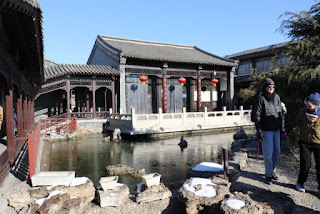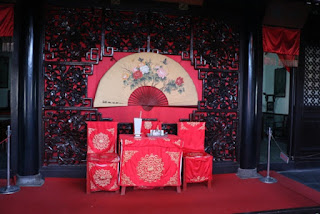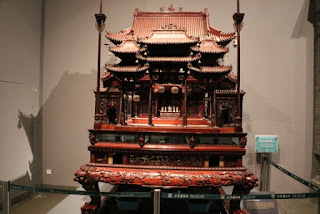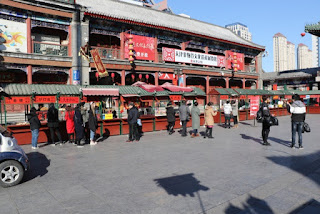Today the ship spent the night in Xingang. At 7 AM I went on a tour called "The Best of Tianjin". Tianjin located north of Xingang is one of the largest city in China. On the 1 1/2 hour drive to Tainjin we drove through the countryside of China. China is planting trees at every blank spot they find. It even looked like they planted trees in old Rice fields. The tour guide said that they are finding that it is cheaper to import rice than to raise their own. At several places outside of Tianjin I saw several places that included a group several tall building with nothing by countryside around them. Our first stop was at the Shi Family Mansion which is called the number one Mansion in North China. Our next stop was at the Tianjin Museum. The Tianjin Museum not only tells the history of the city of Tianjin, but also a large collection of arts and crafts treasures. Our next stop was lunch. We sat at a round table with a lazy susan in the center of the table. Bowls of food was placed on the lazy susan and we took what we wanted. It was a very good meal. After lunch we visited the Confucius Temple and the Ancient Culture Street. We then headed back to the ship and got back at 4:45 PM. Tonight after dinner the show was put on by Tian Jiang, a Internationally renowned pianist. He was born in China but for the last 30 years had lived in New York City. He was very good. He was also on the World Cruise in 2015.
The Port of Tianjin also Port of Xingang formerly known as the Port of Tanggu, is the largest port in Northern China and the main maritime gateway to Beijing. The name "Tianjin Xingang", which strictly speaking refers only to the main seaport area, is sometimes used to refer to the whole port. The port is on the western shore of the Bohai Bay, centred on the estuary of the Haihe River, 170 km southeast of Beijing and 60 km east of Tianjincity. It is the largest man-made port in mainland China, and one of the largest in the world. It covers 121 square kilometers of land surface, with over 31.9 km of quay shoreline and 151 production berths at the end of 2010.
Tianjin Port handled 500 million tons of cargo and 13 million TEU of containers in 2013, making it the world's fourth largest port by throughput tonnage and the ninth in container throughput. The port trades with more than 600 ports in 180 countries and territories around the world. It is served by over 115 regular container lines run by 60 liner companies, including all the top 20 liners. Expansion in the last two decades has been enormous, going from 30 million tons of cargo and 490,000 TEU in 1993 to well beyond 400 million tons and 10 million TEU in 2012. Capacity is still increasing at a high rate, with 550–600 Mt of throughput capacity expected by 2015.
The port is part of the Binhai New Area district of Tianjin Municipality, the main special economic zone of northern China, and it lies directly east of the TEDA. The Port of Tianjin is at the core of the ambitious development program of the BNA and, as part of that plan, the port aims to become the primary logistics and shipping hub of North China.
On 12 August 2015, at least two explosions within 30 seconds of each other occurred at a container storage station at the Port of Tianjin in the Binhai New Area of Tianjin, China. The cause of the explosions was not immediately known, but initial reports pointed to an industrial accident. Chinese state media said that at least the initial blast was from unknown hazardous materials in shipping containers at a plant warehouse owned by Ruihai Logistics, a firm specializing in handling hazardous materials.
Tianjin formerly known in English as Tientsin, is a metropolis in northern coastal Mainland China and one of the five national central cities of the country, with a total population of 15,469,500, and is also the world's 6th-most populous city proper. It is governed as one of the four direct-controlled municipalities of the PRC and is thus under direct administration of the central government. Tianjin borders Hebei Province and Beijing Municipality, bounded to the east by the Bohai Gulf portion of the Yellow Sea. Part of the Bohai Economic Rim, it is the largest coastal city in northern China.
In terms of urban population, Tianjin is the fourth largest in China, after Shanghai, Beijing, and Guangzhou. In terms of administrative area population, Tianjin ranks fifth in Mainland China. The walled city of Tianjin was built in 1404. As a treaty port since 1860, Tianjin has been a major seaport and gateway to Beijing. During the Boxer Rebellion the city was the seat of the Tianjin Provisional Government. Under the Ta-tsing Empire, and the Republic of China, Tianjin became one of the largest cities in the region. At that time, numerous European-style buildings and mansions were constructed in concessions, many of which are well-preserved today. After the founding of the People's Republic of China, Tianjin suffered a depression due to the policy of the central government and Tangshan earthquake, but recovered from 1990s. Nowadays Tianjin is a dual-core city, with its main urban area (including the old city) located along the Hai River, which connects to the Yellow and Yangtze Rivers via the Grand Canal; and Binhai, a New Area urban core located east of the old city, on the coast of Bohai Sea. As of the end of 2010, around 285 Fortune 500 companies have set up base in Binhai, which is a new growth pole in China and is a hub of advanced industry and financial activity.
This picture was taken from the bus on the way to Tianjin, China. China has planted trees at almost every spot that they can.
This picture was taken from the bus. We say several places along the road Tianjin where this type of housing was built out in the country.
This is a picture of the bullet train tracks as taken from the bus.
This picture was taken from the bus of a power plant.
This was our first stop on the tour to Tianjin. This is a picture of the Grand Canal which goes back to several hundred years before Christ.
This is some of the area outside of of the Shi Family Mansion.
This picture was taken at the Shi Family Mansion.
This picture was taken at the Shi Family Mansion.
This picture was taken at the Shi Family Mansion.
This picture was taken at the Shi Family Mansion.
This picture was taken at the Shi Family Mansion.
This picture was taken at the Shi Family Mansion.
This picture was taken at the Shi Family Mansion.
This picture was taken at the Tianjin Museum.
This picture was taken at the Tianjin Museum.
This picture was taken at the Tianjin Museum.
This picture was taken at the Tianjin Museum.
This picture was taken at the Tianjin Museum.
This picture was taken near the Tianjin Museum.
This is a picture of the Folklore Museum.
This picture was taken from the bus in Tianjin, China
This picture was taken of the restaurant where we had lunch.
This picture was taken in the restaurant where we had lunch. They brought the food and set it on the lazy Susan.
This picture was taken at the Confucius Temple.
This picture was taken at the Confucius Temple.
This picture was taken at the Confucius Temple. This is a statue of Confucius.
This picture was taken at the Confucius Temple.
This picture was taken at the Confucius Temple.
This picture was taken at a stop at the Ancient Culture Street.
This is a picture was taken in Tianjin, China.
This is a picture of the cruise terminal at Xingang, China































No comments:
Post a Comment